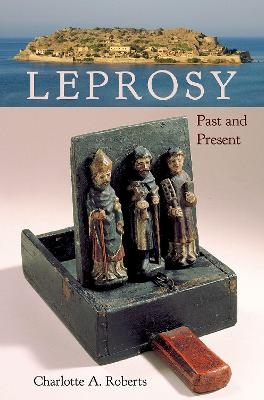
Leprosy
Past and Present
Seiten
2020
University Press of Florida (Verlag)
978-1-68340-184-1 (ISBN)
University Press of Florida (Verlag)
978-1-68340-184-1 (ISBN)
Through an unprecedented multidisciplinary and global approach, this book documents the dramatic 7,000-year history of leprosy using bioarchaeological, clinical, and historical information from a wide variety of contexts, dispelling many longstanding myths about the disease.
Through an unprecedented multidisciplinary and global approach, this book documents the dramatic several-thousand-year history of leprosy using bioarchaeological, clinical, and historical information from a wide variety of contexts, dispelling many long-standing myths about the disease.
Drawing on her 30 years of research on the infection, Charlotte Roberts begins by outlining its bacterial causes, how it spreads, and how it affects the body. She then considers its diagnosis and treatment, both historically and in the present. She also looks at the methods and tools used by paleopathologists to identify signs of leprosy in skeletons. Examining evidence in human remains from many countries, particularly in Europe and including Britain, Hungary, and Sweden, Roberts demonstrates that those affected were usually buried in the same cemeteries as their communities, contrary to the popular belief that they were all ostracized or isolated from society into leprosy hospitals. Other myths addressed by Roberts include the assumptions that leprosy can't be cured, that leprosy is no longer a problem today, and that what is called "leprosy" in the Bible is the same illness as the disease with that name now. Roberts concludes by projecting the future of leprosy, arguing that researchers need to study the disease through an ethically grounded evolutionary perspective. Importantly, she advises against use of the word "leper" to avoid perpetuating stigma today surrounding people with the infection and resulting disabilities. Leprosy will stand as the authoritative source on the subject for years to come.
A volume in the series Bioarchaeological Interpretations of the Human Past: Local, Regional, and Global Perspectives, edited by Clark Spencer Larsen.
Through an unprecedented multidisciplinary and global approach, this book documents the dramatic several-thousand-year history of leprosy using bioarchaeological, clinical, and historical information from a wide variety of contexts, dispelling many long-standing myths about the disease.
Drawing on her 30 years of research on the infection, Charlotte Roberts begins by outlining its bacterial causes, how it spreads, and how it affects the body. She then considers its diagnosis and treatment, both historically and in the present. She also looks at the methods and tools used by paleopathologists to identify signs of leprosy in skeletons. Examining evidence in human remains from many countries, particularly in Europe and including Britain, Hungary, and Sweden, Roberts demonstrates that those affected were usually buried in the same cemeteries as their communities, contrary to the popular belief that they were all ostracized or isolated from society into leprosy hospitals. Other myths addressed by Roberts include the assumptions that leprosy can't be cured, that leprosy is no longer a problem today, and that what is called "leprosy" in the Bible is the same illness as the disease with that name now. Roberts concludes by projecting the future of leprosy, arguing that researchers need to study the disease through an ethically grounded evolutionary perspective. Importantly, she advises against use of the word "leper" to avoid perpetuating stigma today surrounding people with the infection and resulting disabilities. Leprosy will stand as the authoritative source on the subject for years to come.
A volume in the series Bioarchaeological Interpretations of the Human Past: Local, Regional, and Global Perspectives, edited by Clark Spencer Larsen.
Charlotte A. Roberts is professor of archaeology at Durham University and a trained nurse. She is the author of Human Remains in Archaeology: A Handbook, and coauthor of The Bioarchaeology of Tuberculosis: A Global View on a Reemerging Disease and The Archaeology of Disease, among many other books.
| Erscheinungsdatum | 09.10.2020 |
|---|---|
| Reihe/Serie | Bioarchaeological Interpretations of the Human Past: Local, Regional, and Global Perspectives |
| Zusatzinfo | 84 black & white illustrations, 13 tables, 4 appendixes |
| Verlagsort | Florida |
| Sprache | englisch |
| Maße | 155 x 235 mm |
| Gewicht | 1025 g |
| Themenwelt | Studium ► Querschnittsbereiche ► Geschichte / Ethik der Medizin |
| Studium ► Querschnittsbereiche ► Infektiologie / Immunologie | |
| Naturwissenschaften ► Biologie ► Humanbiologie | |
| Sozialwissenschaften ► Ethnologie ► Völkerkunde (Naturvölker) | |
| Sozialwissenschaften ► Soziologie | |
| ISBN-10 | 1-68340-184-0 / 1683401840 |
| ISBN-13 | 978-1-68340-184-1 / 9781683401841 |
| Zustand | Neuware |
| Informationen gemäß Produktsicherheitsverordnung (GPSR) | |
| Haben Sie eine Frage zum Produkt? |
Mehr entdecken
aus dem Bereich
aus dem Bereich
Die Geschichte eines Weltzentrums der Medizin von 1710 bis zur …
Buch | Softcover (2021)
Lehmanns Media (Verlag)
CHF 27,90
von der Antike bis zur Gegenwart
Buch | Softcover (2024)
C.H.Beck (Verlag)
CHF 16,80
Krankheitslehren, Irrwege, Behandlungsformen
Buch | Softcover (2024)
C.H.Beck (Verlag)
CHF 55,90


